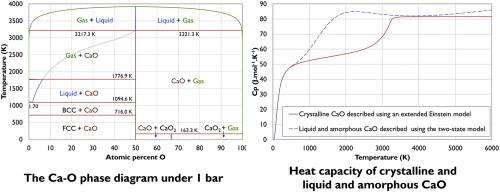Calphad ( IF 1.9 ) Pub Date : 2020-04-13 , DOI: 10.1016/j.calphad.2020.101764 Guillaume Deffrennes , Noël Jakse , Cecilia M.S. Alvares , Ioana Nuta , Alain Pasturel , Alexandra Khvan , Alexander Pisch

|
A complete thermodynamic description of the Ca–O system is proposed including 3rd generation modelling of crystalline CaO, liquid and amorphous CaO, and crystalline CaO2. Compared to previous modellings, a more robust description of the thermodynamic properties of the binary phases is achieved using data recently obtained by density functional theory calculations and molecular dynamics simulations. The heat capacity of crystalline CaO is reassessed, leading to a noticeably higher value below the melting point compared to previous modellings and resulting in a slightly higher standard entropy. It is highlighted that the parameters given in terms of polynomial functions of temperature that were employed so far in 3rd generation models to describe anharmonic contributions in the heat capacity of compounds were not suited to satisfactorily describe the thermodynamic properties of crystalline CaO. It is suggested that this observation can be generalized to most refractory oxides. Alternative terms are proposed in the Gibbs energy function that give more flexibility in fitting the experimental data and lead to more numerically reasonable values for the parameters. The liquid and amorphous CaO phase is described using the two-state model, leading to a significant improvement in the description of its heat capacity. The description of crystalline CaO2 is also improved as only estimates of the thermodynamic properties of the compound were available in previous modellings of the system. Finally, phase equilibria data on the Ca–CaO liquidus is reviewed, and it is highlighted that slight discrepancies in the relatively low temperature measurements can lead to significantly different descriptions of the liquid phase.
中文翻译:

Ca–O系统的热力学建模,包括第三代CaO和CaO 2的描述
提出了有关Ca–O系统的完整热力学描述,其中包括晶体CaO,液体和非晶CaO以及晶体CaO 2的第三代建模。与以前的模型相比,使用最近通过密度泛函理论计算和分子动力学模拟获得的数据,可以更可靠地描述二元相的热力学性质。重新评估了结晶CaO的热容,与以前的模型相比,导致熔点以下的值明显更高,并且导致标准熵稍高。需要强调的是,到目前为止,在第三代模型中用来描述化合物热容量中的非谐贡献的根据温度的多项式函数给出的参数并不适合令人满意地描述晶体CaO的热力学性质。建议该观察可推广到大多数难熔氧化物。在吉布斯能量函数中提出了替代项,这些替代项在拟合实验数据时具有更大的灵活性,并导致参数在数值上更合理。使用两态模型描述了液相和无定形CaO相,从而导致了对其热容量描述的重大改进。结晶CaO的描述由于在该系统的先前建模中仅可获得该化合物的热力学性质的估计值,因此图2也得到了改进。最后,回顾了Ca–CaO液相线的相平衡数据,并着重指出,相对较低的温度测量中的细微差异可能会导致液相的描述大不相同。











































 京公网安备 11010802027423号
京公网安备 11010802027423号